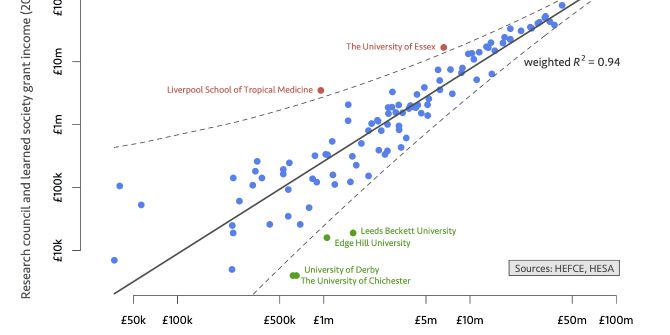 As the submission deadline for REF2014 draws nearer, there is a need to reflect on how the subsequent allocation of funding will affect the UK research environment. Dorothy Bishop argues that the rumoured funding formula would dramatically increase the gulf between the elite and other institutions and that if funding continues to be concentrated only in elite institutions with a high proportion of research superstars, we may be creating an imbalance that will be bad for UK research in the long run.
As the submission deadline for REF2014 draws nearer, there is a need to reflect on how the subsequent allocation of funding will affect the UK research environment. Dorothy Bishop argues that the rumoured funding formula would dramatically increase the gulf between the elite and other institutions and that if funding continues to be concentrated only in elite institutions with a high proportion of research superstars, we may be creating an imbalance that will be bad for UK research in the long run.
So you’ve slaved over your departmental submission for REF2014, and shortly will be handing it in. A nervous few months await before the results are announced. You’ve sweated blood over deciding whether staff publications or impact statements will be graded as 1*, 2*, 3* or 4*, but it’s not possible to predict how the committee will judge them, nor, more importantly, how these ratings will translate into funding. In the last round of evaluation, in 2008, a weighted formula was used, such that a submission earned 1 point for every 2* output, 3 points for every 3* output, and 7 points for every 4* output. Rumour has it that this year there may be no money for 2* outputs and even more for 4*. It will be more complicated than this, because funding allocations will also take into account ratings of ‘impact statements’, and the ‘environment’.
I’ve blogged previously about concerns I have with the inefficiency of the REF2014 as a method for allocating funds. Today I want to look at a different issue: the extent to which the REF increases disparities between universities over time. To examine this, I created a simulation which made a few simple assumptions. We start with a sample of 100 universities, each of which is submitting 50 staff in a Unit of Assessment. At the outset, we start with all universities equal in terms of the research quality of their staff: they are selected at random from a pool of possible staff whose research quality is normally distributed. Funding is then allocated according to the formula used in RAE2008.

The key feature of the simulation is that over every assessment period there is turnover of staff (estimated at 10% in simulation shown here), and universities with higher funding levels are able to recruit replacement staff with higher scores on the research quality scale. These new staff are then the basis for computing funding allocations in the next cycle – and so on, through as many cycles as one wishes. This simulation shows that funding starts out fairly normally distributed, but as we progress through each cycle, it becomes increasingly skewed, with the top-performers moving steadily away from the rest (Figure A). In the graphs, funding is shown over time for universities grouped in deciles, i.e., bands of 10 universities after ranking by funding level.
Depending on specific settings of parameters in the model, we may even see a bimodal distribution developing over time: a large pool of ‘have-nots’ vs an elite group of ‘haves’. Despite the over-simplifications of the model, I would argue that it captures an essential feature of the current funding framework: funding goes to those who are successful, allowing them to enter a positive feedback loop whereby they can recruit more high-calibre researchers and become even more successful – and hence gain even more funds in the next round. For those who are unsuccessful, it can be hard to break out of a downward spiral into research inactivity.
We could do things differently. Figure B shows how tweaking the funding model could avoid opening up such a wide gulf between the richest and poorest, and retain a solid core of middle-ranking universities.


Figure C, on the other hand, shows how a formula that predominantly rewards 4* outputs (weighting of 1 for 3* and 7 for 4*, which is rumoured to be a possible formula used in REF2014). This would dramatically increase the gulf between the elite and other institutions.
I’m sure people will have very different views about whether or not the consequences illustrated here are desirable. One argument is that it is best to concentrate our research strength in a few elite institutions. That way the UK will be able to compete with the rest of the world in University league tables. Furthermore, by pooling the brightest brains in places where they have the best resources to do research, we have a chance of making serious breakthroughs. We could even use biblical precedent to justify such an approach: the Matthew effect refers to the biblical parable of the talents, in which servants are entrusted different sums of money by their master, and those who have most make the best use of it. There is no sympathy for those with few resources: they fail to make good use of what they do have and end up cast out into outer darkness, where there is weeping and gnashing of teeth. This robust attitude characterises those who argue that only internationally outstanding research should receive serious funding.
However, given that finances are always limited, there will be a cost to the focus on an elite; the middle-ranking universities will get less funding, and be correspondingly less able to attract high-calibre researchers. And it could be argued that we don’t just need an elite: we need a reasonable number of institutions in which there is a strong research environment, where more senior researchers feel valued and their graduate students and postdocs are encouraged to aim high. Our best strategy for retaining international competitiveness might be by fostering those who are doing well but have potential to do even better. In any case, much research funding is awarded through competition for grants, and most of this goes to people in elite institutions, so these places will not be starved of income if we were to adopt a more balanced system of awarding central funds.
What worries me most is that I haven’t been able to find any discussion of this issue – namely, whether the goal of a funding formula should be to focus on elite institutions or distribute funds more widely. The nearest thing I’ve found so far is a paper analysing a parallel issue in grant awards (Fortin & Curry, 2013) – which comes to the conclusion that broader distribution of smaller grants is more effective than narrowly distributed large grants. Very soon, somebody somewhere is going to decide on the funding formula, and if rumours are to be believed, it will widen the gap between the haves and have-nots even further. I’m concerned that if we continue to concentrate funding only in those institutions with a high proportion of research superstars, we may be creating an imbalance in our system of funding that will be bad for UK research in the long run.
This blog was originally published on the author’s personal blog, BishopBlog and can be found here along with a further discussion. For further discussion on this post, please see the original post.
Note: This article gives the views of the author, and not the position of the Impact of Social Science blog, nor of the London School of Economics. Please review our Comments Policy if you have any concerns on posting a comment below.
Dorothy Bishop is Professor of Developmental Neuropsychology and a Wellcome Principal Research Fellow at the Department of Experimental Psychology in Oxford and Adjunct Professor at The University of Western Australia, Perth. The primary aim of her research is to increase understanding of why some children have specific language impairment (SLI). Dorothy blogs at BishopBlog and is on Twitter @deevybee.







